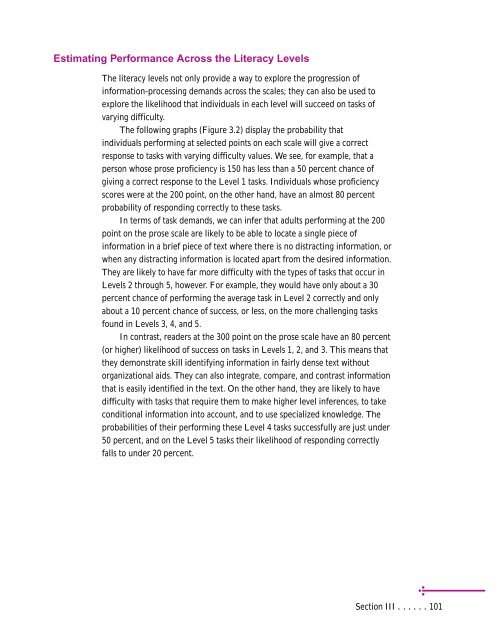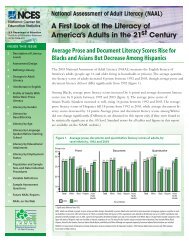Adult Literacy in America - National Center for Education Statistics ...
Adult Literacy in America - National Center for Education Statistics ...
Adult Literacy in America - National Center for Education Statistics ...
Create successful ePaper yourself
Turn your PDF publications into a flip-book with our unique Google optimized e-Paper software.
Estimat<strong>in</strong>g Per<strong>for</strong>mance Across the <strong>Literacy</strong> Levels<br />
The literacy levels not only provide a way to explore the progression of<br />
<strong>in</strong><strong>for</strong>mation-process<strong>in</strong>g demands across the scales; they can also be used to<br />
explore the likelihood that <strong>in</strong>dividuals <strong>in</strong> each level will succeed on tasks of<br />
vary<strong>in</strong>g difficulty.<br />
The follow<strong>in</strong>g graphs (Figure 3.2) display the probability that<br />
<strong>in</strong>dividuals per<strong>for</strong>m<strong>in</strong>g at selected po<strong>in</strong>ts on each scale will give a correct<br />
response to tasks with vary<strong>in</strong>g difficulty values. We see, <strong>for</strong> example, that a<br />
person whose prose proficiency is 150 has less than a 50 percent chance of<br />
giv<strong>in</strong>g a correct response to the Level 1 tasks. Individuals whose proficiency<br />
scores were at the 200 po<strong>in</strong>t, on the other hand, have an almost 80 percent<br />
probability of respond<strong>in</strong>g correctly to these tasks.<br />
In terms of task demands, we can <strong>in</strong>fer that adults per<strong>for</strong>m<strong>in</strong>g at the 200<br />
po<strong>in</strong>t on the prose scale are likely to be able to locate a s<strong>in</strong>gle piece of<br />
<strong>in</strong><strong>for</strong>mation <strong>in</strong> a brief piece of text where there is no distract<strong>in</strong>g <strong>in</strong><strong>for</strong>mation, or<br />
when any distract<strong>in</strong>g <strong>in</strong><strong>for</strong>mation is located apart from the desired <strong>in</strong><strong>for</strong>mation.<br />
They are likely to have far more difficulty with the types of tasks that occur <strong>in</strong><br />
Levels 2 through 5, however. For example, they would have only about a 30<br />
percent chance of per<strong>for</strong>m<strong>in</strong>g the average task <strong>in</strong> Level 2 correctly and only<br />
about a 10 percent chance of success, or less, on the more challeng<strong>in</strong>g tasks<br />
found <strong>in</strong> Levels 3, 4, and 5.<br />
In contrast, readers at the 300 po<strong>in</strong>t on the prose scale have an 80 percent<br />
(or higher) likelihood of success on tasks <strong>in</strong> Levels 1, 2, and 3. This means that<br />
they demonstrate skill identify<strong>in</strong>g <strong>in</strong><strong>for</strong>mation <strong>in</strong> fairly dense text without<br />
organizational aids. They can also <strong>in</strong>tegrate, compare, and contrast <strong>in</strong><strong>for</strong>mation<br />
that is easily identified <strong>in</strong> the text. On the other hand, they are likely to have<br />
difficulty with tasks that require them to make higher level <strong>in</strong>ferences, to take<br />
conditional <strong>in</strong><strong>for</strong>mation <strong>in</strong>to account, and to use specialized knowledge. The<br />
probabilities of their per<strong>for</strong>m<strong>in</strong>g these Level 4 tasks successfully are just under<br />
50 percent, and on the Level 5 tasks their likelihood of respond<strong>in</strong>g correctly<br />
falls to under 20 percent.<br />
Section III ......101



